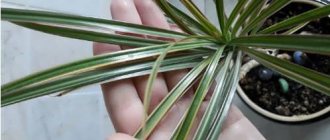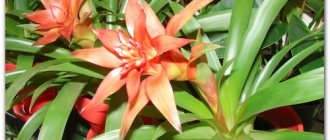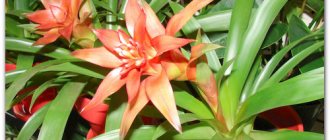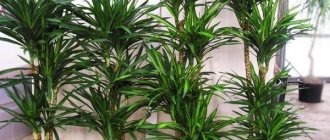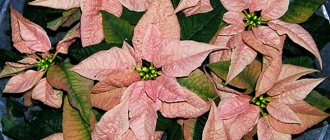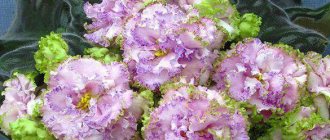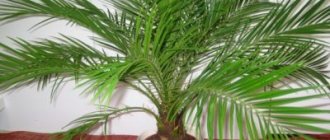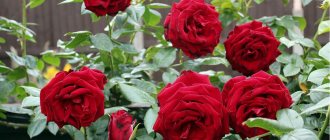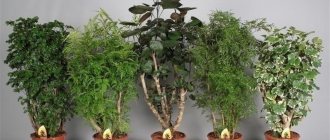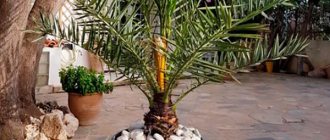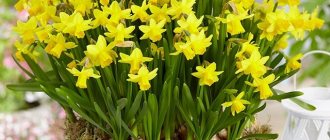Dracaena (lat. Dracaena) is better known under the names “dragon tree” and “tree of happiness” . It comes from Africa and is also found in South Asia and Central America. Previously, there was an opinion that it belonged to the Agavov and Iglitsev family. Currently, it belongs to the Asparagus .
The word "dracaena" comes from the Greek language and translates as "female dragon." This is due to the fact that from the cracks of some varieties of dracaena a gum is released, the dark red hue of which resembles blood.
Dracaena is characterized by a tree-like form. The trunk reaches a height of 30 cm to 3 m . The linear, lanceolate leaf blades have a dense leathery texture and form a tuft at the top of the plant. Due to its strong resemblance to a palm tree, this succulent received another name - “false palm”.
Dracaena at home
Dracaena is suitable for growing in greenhouses, winter gardens, insulated loggias and balconies, in the halls of restaurants, hotels, it will decorate any music room of a kindergarten or school, it is an excellent plant for the office.
Any type of dracaena is well suited for growing at home, for the reason that they do not need cold wintering, such as many cacti, cycas or conifers. Artificial trees also require no maintenance.
When choosing a dracaena for your home, you need to consider how much space it will be given, because... Among the various types of dracaenas there are giant, dwarf, and quite compact forms of the plant. Young plants take up little space, but over time they grow and are not removed from the windowsill. You have to plant them in large pots and place them in the room. At the same time, variegated varieties require mandatory additional lighting. Use fluorescent lamps or LED lamps; for one large plant, 1.5 m high, you need approximately 2-3 lamps with a power of 20 W, and they should be placed no further than 20 cm from the crown, so that all parts of the plant are illuminated as evenly as possible .
The second feature of growing dracaena at home concerns large tub plants, for example, fragrant dracaena can grow to the ceiling and the span of its leaves is about 1-1.2 m. Such a specimen can only grow in a tub or a very large flowerpot, about 40-50 l. Naturally, this creates difficulties during replanting; such plants are replanted rarely, once every few years, but the top layer of soil is changed annually, especially if a coating of salts has been deposited on it. The soil must first be loosened, then removed with a scoop and topped with fresh soil or well-rotted compost.
The most unpretentious species: Dracaena marginalata, Dracaena fragrant, Dracaena derema - larger, Dracaena Godsefa, Dracaena reflexum - more compact. By the way, out of all the variety of more than a hundred species of dracaenas, about 15 species are grown as indoor plants.
Where did dracaena come from, and what types can you grow at home?
The homeland of dracaena is the tropical forests of America, Africa and Asia, as well as the Canary Islands. It can be safely classified as a palm plant; it looks like a palm tree: under favorable conditions it can reach 20 meters in length, while the trunk is most often bare, and the foliage forms a crown in the upper part. The root system is smooth and even with a hint of rust. There are several decorative types of dracaena that are grown at home.
Dracaena fragrant (Frangrance, Malaika) - the flower received its name due to the pleasant aroma emanating from the inflorescence. When flowering, more than one flower is formed; the palm tree has a peduncle that grows in the center of the rosette; small flowers appear on it in large numbers, which are the source of the smell. At home, fragrant dracaena blooms very rarely, only in ideal conditions. A flowering plant can be found either in its homeland or in a botanical garden.
As a houseplant, fragrant dracaena is found both tall and dwarf. The leaves are succulent, dense, and have a refined curve. They can reach half a meter in length with a width of 10 cm. The leaves form a crown at the top of the trunk, which becomes bare due to the falling of leaves during plant growth. Often among the varieties of broad-leaved fragrant dracaena there are specimens with decorative leaf colors: Lindenii, Massangeana, Surprise.
Derema dracaena grows tall, even in a small pot. It differs from other species in the abundance of succulent foliage on the trunk. Some varieties have light green leaves 5 cm wide and about 50 cm long. Other varieties have variegated leaves on a green background. The foliage shape is elongated with a smooth surface. This palm tree will not please you with its flowering; all that remains is to enjoy its exotic appearance. The following varieties of Derham dracaena have been bred for home keeping: Janet Craig Compacta, Lemon Lime, Warneckii, White Stripe.
Among other species, the most common is dracaena marginata. In its homeland (the island of Madagascar) it can grow up to 6 meters in height. Due to the decorative appearance of its long, thin leaves, this variety is sometimes called dragonwood. The length of the leaf reaches 70 cm, the width is from 1 to 1.5 cm. Flower growers call it Marginata. At home, the plant is kept in containers. As it grows, the trunk becomes bare, and decoratively colored leaves form a crown. In its homeland, the plant not only blooms, but also bears fruit. At home, a racemose inflorescence can be seen extremely rarely. The varieties Colorama, Sandera, Bicolor, and Tricolor are popular among gardeners.
Dracaena dragon can grow up to 18 meters in height with a trunk diameter of 5 meters. At home its height does not exceed 1.5 meters. The foliage is oblong, elastic, pointed at the ends. Each shoot is crowned with a bunch of leaves 60 cm long and 3 cm wide. If the flower is well lit, the edging becomes pink. As they grow, the lower leaves turn yellow and fall off.
Dracaena Godsefa is impressive in its appearance, as it is not similar to other varieties of the plant. It grows as a bush with leaves about 10 cm long and shaped like an egg. It grows up to 70 cm in height. The leaves have varied shades: from greenish to beige. Has shoots in the form of wire. It begins to bloom almost immediately after planting with fragrant light green flowers. After flowering, fruits appear in the form of berries. Godsefa is not afraid of the temperature dropping.
Dracaenas have a positive effect on the human nervous system, give a good mood and bring peace of mind.
Types of dracaenas
When to plant dracaena
At home, dracaena can be planted throughout the growing season. The best time is spring, when sap flow and other vital processes are activated. The plant accepts various types of fertilizers well.
It is best to plant dracaena in the spring during the intensive growing season.
Many gardeners use the lunar calendar, taking into account favorable and unfavorable days for planting.
Temperature
Dracaena prefers moderate temperatures; in summer it can suffer from extreme heat when the temperature is above 32°C. To alleviate its condition, temporarily move the pot to a cooler place, ventilate the house more often and spray the leaves. Monitor watering carefully and do not allow it to dry out. Since October, the illumination drops sharply, at home it can be very dark even on the windowsill, and if the plant is standing near a window or slightly away, high temperatures are harmful to the plant - moderate temperatures within 15-18 ° C are desirable, it can be kept on an insulated balcony up to 10 - 12°C with limited watering. If it is not possible to provide coolness, protect the plants from central heating radiators (with a screen, wet sheets on the radiator). In a warm room with a lack of light, dracaenas very quickly lose their lower leaves and decorative appearance. Therefore, the only way to preserve the plant’s health and beauty is additional lighting.
Brief botanical description
Dracaena (dracaena) is an evergreen plant from the asparagus family. The tree form is more common, and the shrub form is less common.
Under natural conditions, the height of trees reaches 6 m, indoors - no more than 3 m. Long sword-shaped leaves are collected in bunches (apical rosettes).
As it grows, the lower leaves dry out and fall off, the trunk becomes bare, and a bunch of densely collected cascading leaves remains on the top of the head. Due to their external similarity, tree-like dracaenas are often called “false palms.”
Dracaena belongs to the Agave family.
Lighting
You need a bright place, partial shade, dracaena does not tolerate direct sunlight only from 11 a.m. to 4 p.m. Many people consider dracaena to be a shade-loving plant, but in fact, it will wither in a dark place. Intense light is needed for good growth and development. Variegated forms require more lighting than forms with green leaves. The issue of lighting large plants in winter is especially acute. Such large dracaenas are bought or given as a gift to decorate rooms, but they rarely think that they need light.
Dracaena also grows well in artificial light, so arrange illumination with fluorescent lamps (for a plant about 1.5 m tall you need 2-3 lamps with a power of 15-18 W) or LED. The lamps should be placed so that the crown is illuminated most evenly. By the way, the most shade-tolerant species is Dracaena fragrant (not the variegated version). If you live in central Russia, then keep in mind that from mid-September to January, dracaena is not afraid of even the midday sun from a southern window (the sun is low and rare to cause burns).
Brief description of care
- Optimal temperature parameters: from +18 to +28°C .
- Humidity should be at least 60% .
- Lighting is diffused, soft, partial shade. Avoid exposure to direct sunlight.
- Thorough watering twice a week in the summer and once every ten days in the winter. Avoid overwatering.
- Feeding is necessary during the period of active growth.
- The soil should be slightly acidic and loose. Requires annual replacement of the top layer.
- Replanting is needed immediately after purchase and annually in early spring.
- Pruning is done at the beginning of the growing season. To rejuvenate a tree, the entire top part is cut off and rooted.
- In many species of dracaena, dormancy occurs in winter; watering and fertilizing at this time are reduced.
- Flowering begins after 5-7 years at temperatures from +25 to +35 ° C and humidity of about 65% .
Watering
In summer or winter, with good lighting in a warm room (above 24°C), water abundantly after the top layer of soil has dried (about half the height of the pot). In winter, under cool conditions, especially with poor lighting, dracaenas are watered moderately or limitedly, taking into account the temperature in the room (for example, when kept at a temperature of about +8 ° C, the soil in the pot should always be almost completely dry, watering is scanty, about once every 1 ,5 months). Do not overdo it with watering - all dracaenas do not tolerate stagnation of water in the pot, as well as prolonged drying of the earthen clod. If you are in doubt about watering or it’s too early, wait. To avoid waterlogging, check whether the drainage holes are clogged with expanded clay or soil, and be sure to add drainage to the bottom of the pot when replanting. Small dracaenas are suitable for growing hydroponically.
Replanting and pruning - to make the plant comfortable
After purchasing the dracaena, we give it time to adapt - about 21 days, then transplant it into another pot. We carry out the transshipment carefully together with a lump of earth, in order to avoid damage to the root system. We fill the free space with pre-purchased soil or prepared soil ourselves. If you prepare the mixture yourself, take the following components:
- turf land;
- leaf soil;
- peat;
- humus;
- coarse sand.
Mix all components in equal proportions. For disinfection, add wood ash. We put drainage at the bottom of the pot. When choosing a flowerpot, we evaluate the size of the plant. If its height is 40 cm, then we take a container with a diameter of 16 cm.
We replant a young palm tree regularly once a year; an old plant does not need frequent replanting, so it is better to replant it once every 2-3 years. The best time for replanting is considered to be the time when the plant comes out of dormancy: late winter-early spring. We transplant the plants into containers 2-3 cm larger than the previous one. Add the required amount of soil, water and place in a warm place. When the soil settles, add more soil if necessary.
To give the palm a beautiful shape or to prevent the spread of the disease, we perform pruning, which is best done in winter, when the plant is dormant. For pruning we use garden shears. Before the procedure, we must disinfect the instrument. After cutting, sprinkle the cut area with wood ash or crushed coal. If you cut off the top of a palm tree, new shoots will begin to grow from the sides.
If we do pruning for branching, then we prune plants that have reached a height of 30 cm. We cut the shoots 6 cm below the last leaves or leave the height necessary to form the shape of the bush. After 17-25 days, buds appear under the cut, from which side shoots subsequently grow. After pruning, we provide the plant with good lighting, watering and spraying so that new branches grow better.
Fertilizer
During the growth period from April to August, dracaenas are fed every two weeks with complex fertilizers for indoor plants. The ideal ratio of the main macroelements in NPK fertilizer is 3:1:3, somewhat worse than 3:1:2. It is quite difficult to select fertilizers, but you can, for example, “Stimulus for decorative deciduous organomineral fertilizer” - NPK 3: 1.5: 2 and microelements S, Mg, Fe, Mn, Cu, Zn, B, Mo. Not everyone from the Agricola line is suitable, perhaps only Agricola for ficuses, it has an NPK of 24:11:18, an additional 0.5% MgO and trace elements, if you recalculate the NPK ratio, it is approximately 3:1.38:2, 25 - will completely satisfy the needs of dracaena. Other fertilizers for deciduous trees have too high a dose of phosphorus; fertilizing with such fertilizers will lead to the formation of necrotic (dark brown) spots along the edges of the leaves.
Don’t look for special fertilizers for dracaenas, look for a suitable NPK ratio, for example, Bona Forte also has fertilizer for ficuses or for decorative deciduous trees - but they also contain too high a dose of phosphorus. But Bon Forte has a liquid Lawn Fertilizer - this is a complex mineral fertilizer, with NPK 7: 3.5: 7 - practically what we need + 7 microelements: Boron, iron, manganese, zinc, copper, molybdenum, cobalt.
All you need to do is find a fertilizer with the correct NPK ratio and convert it to the required amount of water. For example, fertilizer “for lawns” from Bon Forte will need to be diluted twice as much as the dosage recommended on the package, and fertilizer “Stimul” must be diluted according to the instructions.
Watering and fertilizing - complete nutrition
In order for the plant to have lush greenery and a healthy appearance, it must be properly watered. Features of watering depend on the specific variety, but there are general recommendations. The growth period for palm trees occurs in the spring-summer season, so at this time we water abundantly. Between waterings we take a break of about 8 days, the surface layer should dry out by 2-3 cm. We take soft water for irrigation; it is better to boil or filter tap water. It is important that the water contains as few impurities as possible; fluorine and its compounds are especially harmful. Before each watering, we loosen the soil.
In autumn, we reduce watering, as the soil dries more slowly. In winter, the plant rests, so it is enough to water it several times a month. The reference point is the soil. If the plant is located near a heating device, the soil dries faster and you have to water it more often. Frequent watering can have a detrimental effect on the root system of the dracaena, which can begin to rot, resulting in the death of the flower. Therefore, be careful when watering. We spray the leaves regularly, wipe the leaves once a month to remove dust and dirt. Sometimes it is useful for a plant to give it a warm shower.
We select complex fertilizers or mixtures for deciduous plants for dracaena, which are sold in specialized stores. It is better to buy fertilizers in liquid form. Add them to the water and water the flowers with this solution. We feed the plants during the period when they are actively growing - from early spring to autumn. We fertilize once every 2 weeks, in the winter season - no more than once a month.
To accelerate growth, dracaena needs phosphorus, nitrogen and potassium. When choosing fertilizers, pay attention that the named elements are present in the composition; they must be in a ratio of 1: 3: 3, as listed. The drug Zircon, which is intended for growing palm trees, is popular. We dilute it according to the instructions and add it to the water for irrigation.
How to replant dracaena
Dracaena should be replanted at the beginning of a new growth cycle - in spring, early summer. Young plants need to be replanted annually, as plants grow vigorously, quickly using up nutrients. Old dracaenas (over 6-7 years old) can be replanted every two to three years.
It is better to compose the soil for dracaena yourself from various components: 1 part turf soil, 1 part leaf soil, 1 part rotted manure (compost) and 1 part coarse sand (more precisely, fine gravel 3-4 mm in size).
If you use soil for dracaenas from a store, choose trusted manufacturers (for example, Terra Vita Living Earth). But to such soil it is advisable to add 1/5 of the volume of fine gravel or coconut shavings (chips) and the same amount of compost (humus). But in any case, the soil must be sterilized.
The root system of dracaenas is relatively small and rather superficial; it does not tolerate waterlogging, so the pot has high drainage. You can plant dracaenas in purchased soil for palm trees and other large plants, or in universal soil. However, it is a good idea to add loosening elements (fine gravel, coconut substrate) to such soil in an amount of 1/5 of the volume of the pot.
What to do immediately after purchase?
A newly purchased plant must be treated with an insecticide (Fitoverm) and a fungicide (Fitosporin-M, Maxim). It is recommended to keep the dracaena in quarantine for several days, separately from other house plants.
It is better to transplant a young plant immediately. It is recommended to replant an adult tree in early spring. The container should be in the shape of a glass, with a narrow bottom and a wider top. The diameter of the new pot should be only a couple of centimeters larger than the previous one. Too large a container can lead to stagnation of water, which is detrimental to the dracaena.
If the plant is brought from abroad, then replanting is a mandatory procedure, since during transportation a special substrate is used, not soil.
Special care requirements for dracaenas
Dracaenas are very sensitive not only to chlorine contained in tap water, but also to elements such as fluorine and boron.
To get rid of chlorine, just let the water sit for 24 hours. However, if there is an excess of fluoride in tap water in your area, settling will not help; filtering reduces its content to some extent, but only slightly. Only filters with reverse osmosis are better at purifying water from this chemical element. If you do not have such a filter, the best solution is to water your dracaenas with distilled water. In addition, it is important to avoid fertilizers and soils containing superphosphates - they have a high fluorine content. Perlite and vermiculite are also prohibited for dracaenas - they contain high levels of fluoride.
Acidity is also important, so that plants do not get fluoride poisoning, maintain the soil pH in the region of 6-6.5 units (the amount of fluoride bound by the soil increases as the pH decreases). When the acidity pH is below 6.0, dracaena may experience leaf spotting, necrosis of the tips and edges of leaves - a deficiency of Potassium, possibly simultaneously with the accumulation of fluoride. Sometimes these are single brown spots located closer to the edges. At a pH above 6.5, iron deficiency occurs and appears as chlorosis, primarily on young leaves.
Pests
The main enemies of dracaena are thrips and scale insects . Spider mites attack less frequently.
Thrips infestation is characterized by yellowing of the foliage and the appearance of a silvery sheen. Small black insects with an elongated body are located in groups on the underside of the foliage and suck out cell sap. When attacked by scale insects, the leaves wilt. Remove insects using a cloth soaked in soapy water.
Parasites are destroyed by treatment with insecticides (Aktellik, Mospilan, Karbofos, Itavir, Fitoverm). Spider mites envelop the back side of the leaf plate with a web, which leads to the appearance of yellowness. The leaves are washed with warm water and treated with Deris .
Frequent spraying of the plant is also used as a preventive measure against pests.
Spraying dracaena
How to propagate dracaena
Dracaena - propagation Dracaena can be propagated by seeds and cuttings (pieces of stem). In any case, propagation is best carried out from the end of February to May, so that the seedlings or rooted cuttings have time to get stronger by winter.
Before planting, seeds should be soaked for a day in water at room temperature. It is possible, but not necessary, to add growth stimulants - epin or zircon - to the water. Plant the dracaena in a small pot (8-10 cm in diameter), to a depth of no more than 1 cm. You need to add expanded clay drainage to the bottom of the pot. The soil is a universal peat or soil for seedlings; you can add a tablespoon of coconut substrate (from briquettes) to it. Be sure to sterilize the soil! Plant the cutting and water the soil in the pot. Now you need to create increased humidity - place the pot in a transparent bag or cover it with a jar. Ventilate twice a day.
Germination takes on average 2 weeks, sometimes longer. But even if the seeds have not sprouted within a month, do not be discouraged, they can linger for up to three months. Caring for crops is like caring for any other flowers - it is important not to overwater them or overdry them. The soil should be constantly moderately moist. If they stretch noticeably, organize additional lighting.
Dracaena, which has become elongated and bald in the lower part of the trunk, is most often propagated by apical cuttings or pieces of a trunk at least 10 cm long. In spring, cuttings take root well in water (1 liter of boiled water, add 1 tablet of activated carbon). The roots appear within 1-3 months. When they grow to a length of 5 cm, you can plant the dracaena in a pot. Rooting dracaena in the ground using heteroauxin and heating the soil is also practiced, but only small cuttings. In this case, the soil must be sterilized, and the plant itself must be placed in a ventilated greenhouse. By the way, at the place where the cuttings are cut, new shoots from the lateral buds will appear on the mother plant.
3 propagation methods - choose any
Dracaena has another name - the tree of happiness. The American Indians have a legend about how a young warrior fell in love with the chief’s daughter and was able to marry her after he stuck a stick in the ground and on the fifth day, after regular watering, leaves appeared on it. This legend is not only about a beautiful love story, but also about one of the methods of propagation of dracaena.
Dracaena reproduces in three ways:
- seeds;
- bends;
- cuttings.
The best time for these procedures is spring.
Seed method
The seed propagation method is the most labor-intensive. We grow dracaena from scratch from purchased seeds:
- First we germinate the seeds. To do this, place them in water at a temperature of 26-30 degrees or a stimulating solution for 24 hours.
- When the sprouts appear, we make depressions in the previously prepared soil, put the seeds in them and sprinkle them with earth.
- To create greenhouse conditions, cover with film and place the container in a warm, sufficiently lit place.
- We regularly ventilate and water the seeds.
- If you follow the growing rules, seedlings should appear in one and a half to two months. When the sprouts grow to a height of 6-7 cm, they need to be planted in permanent flowerpots.
It will take about 2 years to grow dracaena from seeds.
Propagation by cuttings
For cuttings, you need to take a shoot from an adult plant. To do this, we cut off only strong shoots about 10 cm long. Then we divide it into parts of about 3 cm so that there are 2-3 buds on each piece of shoot. We treat the cut areas with paraffin to prevent infection and reduce moisture evaporation. We cut each piece lightly on one side and place it in a prepared soil substrate consisting of vermiculite, sand and peat.
Next, to create a greenhouse effect so that the cuttings take root faster and shoots appear faster, cover the container with polyethylene or a cut plastic bottle. We periodically remove the film to ventilate and water the seedling. We protect the planted cuttings from direct sunlight and, if necessary, shade the location of the containers. In about a month, the first leaves should appear. Now we remove the film and continue caring for it as we would for an adult dracaena.
Reproduction by layering
When propagating using apical layering, we cut off the top of the palm tree along with the leaves with a sharp, disinfected knife. The distance from the last leaves to the cut should be at least 15 cm. Let the layer dry, then place it in warm water to root. Dissolve an activated carbon tablet in water or add wood ash to prevent diseases and purify the water. Place the container with the layering in a warm, illuminated place. Add settled water as needed. After 60-70 days, the plant will take root; it needs to be transplanted into a pot filled with good drainage and prepared soil.
There is another way to obtain layering without cutting off the top. We make a T-shaped cut on the trunk, put a small amount of peat in it, and wrap it with plastic wrap. After 30 days, roots should appear. We cut off the resulting branch and plant it in a pot with soil and drainage.
Dracaena turns yellow
- Brown, dry tips or edges of leaves - if the leaves are elastic, the cause is too dry air or insufficient watering.
This dracaena has two problems: too much watering and too large a pot, in which the soil turns sour and the roots rot. - Limp, drooping leaves of dracaena can be a sign not only of a regular flood, but also of hypothermia, especially if the root system was damp (a cold night on the balcony, transportation from the store to home).
The main problem with this dracaena is the lack of light, so the lower part of the trunk becomes bald, and the crown reaches towards the light. - Yellowing of leaves - if the leaves are elastic and not flaccid, then the cause may be insufficient watering, lack of nutrition, if they have not been replanted for a long time. If the air is too dry, directed (from the battery), then in addition to yellowing, there may be dry round spots on the leaves, usually gray.
Dracaena fragrant is very shade-tolerant, and such yellowing of the leaves is evidence of a violation of watering (overdrying, overwatering, or, what happens more often, first severe drying out, and then excessive watering).This dracaena was frozen - the leaves turned black from contact with cold air during ventilation. Hypothermia is especially dangerous when the soil in the pot is damp.
This dracaena was watered very diligently - a sure sign of waterlogging and root rot is the death of the top; usually at this stage the plant cannot be saved.
- The lower leaves turn yellow and fall off - it is typical for dracaena to lose the lower leaves, while the upper part of the plant remains leafy. But it can be considered more or less normal for the trunk to be exposed 1/3 from the bottom. If a large part is exposed, then it is worth considering whether the plant has enough light.
- Light large dry spots on the leaves, then turn brown, with clear boundaries - too intense lighting and sunburn. Dracaena needs shade from direct sunlight during the hottest hours of the day.
How to save dracaena if it is sick. If there are signs of a lack of lighting, then move the plant to a brighter place or provide additional lighting with fluorescent lamps.
If the plant suffers from dry air, then, firstly, you can cover the radiators with a damp sheet. Secondly, place the pot with dracaena on a tray with wet pebbles or sphagnum moss. But this will not help a large plant; the only way out is a humidifier.
If the dracaena was flooded, then the degree of its survival depends on how badly the roots were damaged (rotted). In any case, you need to try to save the plant - remove it from the pot, shake off the damp clods of earth and dry the root ball with newspapers or toilet paper. Then plant in dry soil and do not water for about 2 days, then water carefully.
Problems and methods for solving them
Dracaena has a fairly strong immune system, but it may develop some infectious diseases:
- Alternaria blight is characterized by brown-black elongated spots.
- Heterosporosis manifests itself in the form of light brown spots.
- Phyllosticosis occurs when the spots turn yellow and dry out.
Drying leaves of dracaena
The diseased tree must be isolated from other plants to avoid transmission of infection to other plants. All these problems are eliminated with the help of fungicides (Horus, Fundazol, Teldor, Bayleton), sold in a flower shop.
If the spots are putrid in nature, then we are talking about the most dangerous disease - bacteriosis . In this case, the plant usually must be destroyed.
Most often, the cause of deterioration in the health of dracaena is improper care. To restore plant health, you need to recognize the signs and eliminate the cause:
| Brown spots, dying of green foliage. | Exceeding the dosage of fertilizer. |
| The tips of the leaves turned brown, and white spots (efflorescence) appeared on the soil. | Perhaps rot has formed on the roots. It is necessary to inspect the root system, cut off diseased roots, and change the soil. |
| The dried tips of the leaves have a light shade, break, and crumble. | The indoor air is too dry. |
| The foliage is dark, dirty in color. | Excessive watering. |
| The top was bent. | Lighting is distributed unevenly. |
| Burns on leaf blades. | Excessive exposure to direct sunlight. |
| Weak, thin, soft leaves and shoots. | Lack of sunlight. |
| Soft trunk | Excess moisture, rotting of the root system. |
| Leaves curl, whitish spots on foliage. | Too cold water and room temperature (below +15 ° C), dry air. |
Pests of dracaenas
Most often, dracaena is affected by scale insects, thrips and mites.
Scale insects look like brown plaques on the surface of leaves and stems and suck out cell sap. Leaves lose color, dry out, curl and fall off.
Thrips look like small black rods (about 1 mm long), but their excrement is more often noticeable - sticky black droplets. Light dots and streaks appear on the leaves, they quickly merge into large spots. As a result, the upper side of the leaf becomes grayish-brown, with a characteristic silvery sheen.
Control measures. Systemic insecticides help against thrips and scale insects (as well as whiteflies and aphids), especially if the plant is large and difficult to spray thoroughly. The drugs of choice are Aktara and Confidor. These drugs need to be watered on the ground, and they are the safest for humans. You can also spray with contact or enteric contact preparations (Fitoverm, Decis, Actellik, Inta-Vir).
Mites are difficult to detect on a plant until they have formed a huge colony. But if you look closely, on the underside of the leaf you can see a whitish husk, similar to dandruff - the skins of mites and larvae. The leaves of the dracaena become discolored, turn yellow and fall off, and when exposed to the light of the leaf, you can see pinpoint punctures, as if the leaf had been pricked with a needle.
Control measures. Only with the help of acaricide preparations, all of them are intended for spraying. Small dracaena bushes can be saved from ticks if you give them a hot shower: take the plants to the bathroom, lay them on their sides and water them with hot water from the shower for about 2-3 minutes. The water should be approximately 50-55 degrees. After 5-7 days, repeat the dousing from the shower.
You can’t take large plants into the bathroom; you have to use pesticides. But if you are afraid to use poisons (for example, you have children at home), you can try spraying dracaena leaves with a solution of green soap. The solution does not smell, but the effect is rather weak; there is no need to wash off the green soap, leave it until it dries.
Be sure to increase the humidity in the room; mites multiply intensively in dry air and high temperatures.
Read more about pests of indoor plants in the pests section.
Creating tropics in an apartment - how much light does a palm tree need?
Dracaena is a tropical plant and needs warmth and moisture. The plant can grow in partial shade, but it is better to place it in a room in a well-lit place. At the same time, we protect it from direct sunlight and provide diffused lighting. The need for lighting depends on the variegation of the leaves. Varieties with variegated foliage need a lot of light; green leaves do not need a lot of light. If dracaena does not receive enough light, it grows and develops poorly.
If the palm tree is on the windowsill, then the windows should face the east or west side. If the windows face south, then we provide shading. Dracaena will not live long on a north window. These recommendations should be taken into account when choosing a location for the plant. The flower does not like heat either. In summer, a comfortable temperature for her will be from 20 to 25 degrees, in winter - from 15 to 18. If the air in the room is dry, place a container of water next to the pot, and spray the leaves more often with a spray bottle. We maintain indoor air humidity within 60-70%. We regularly ventilate the room, since dracaena needs fresh air, but it does not like drafts.
By the way
In the summer, it is better to place the dracaena in the garden or on the balcony, providing it with shelter from the wind and bright sun. Uniform lighting from all sides in the open air promotes better foliage of the plant.
But before you bring the plants back into your apartment, make sure it is free of pests.
In appearance, Dracaenas are often confused with Cordylines. To distinguish them you will have to remove the plant from the pot. In dracaenas, the roots are even and smooth in color from orange and yellow to light brown, while in cordilina they are white.
In addition, cordylines never form root suckers.
Dracaenas with wide leaves require more abundant watering during the growth period than dracaenas with narrow leaves, since their leaves evaporate more moisture.
It should also be noted that fragrant dracaena, the most broad-leaved of all species, often suffers from mechanical damage. Its leaves are easily bent and cracks and scars form on them.
And dracaenas with narrow leaves (for example, Dracaena marginata) are loved by cats and cats.
Therefore, do not place large plants somewhere in the passage, next to the door. And grow special grass for the cat.
Dracaenas respond very well to periodic loosening of the top layer of soil in pots in spring and summer. This improves soil aeration. If the top layer of soil in a pot with dracaena is covered with a white crust - these are deposits of salts from water and soil, you need to remove the top layer of soil and add fresh soil. And for irrigation use boiled water.
When transplanting dracaenas, add pieces of charcoal (birch) coal and expanded clay (fraction 3-5 mm) to the fresh soil mixture in addition to sand. For a bucket of earth, three handfuls of coals and 0.5 liters of expanded clay. Pieces of coal prevent the development of rotting processes, and brick chips increase the looseness of the soil.
Aftercare for indoor plants
After planting the planting material, a period of active growth and development of dracaena begins, requiring certain knowledge from the grower. Many standard actions are performed in the usual sequence, but at the same time, they also have their own characteristics that must be paid attention to. Let's look at each of them.
Feeding and watering
Regardless of the season, moistening the soil in a pot with dracaena should be done only after it has dried to a depth of 2-3 cm or more. In the summer, this happens on average 1-2 times a week, and with the advent of cold weather and the dormant period, the number of waterings decreases to twice a month. However, these indicators are approximate, because a lot here depends on the air humidity in the room and the type of dracaena (plants with wide leaves use up accumulated moisture faster than representatives with narrow leaf blades).
Did you know? In the development of dracaenas, as in the life of people, there are three main periods: youth, maturity and old age. The plant enters the mature period only after 35 years of active development, but old age lasts even longer, because the total lifespan of some tree species can be thousands of years.
As for water for irrigation, it must be at room temperature and free of chlorine or other additives harmful to plants. In addition to regular watering, fertilizing, often combined with adding liquid to the soil, will be no less important for the tree. Typically, the fertilization period begins in the first warm months and ends in mid-November, 2-3 weeks before the dracaena goes dormant.
Both complex mineral fertilizers for flower plants (sold in gardening stores) and organic solutions of horse manure or mullein are excellent for serving as nutritional compounds. True, in the latter case, such mixtures can be used only 1-2 times per season, choosing a granular form or a liquid concentrate form (diluted in water in a ratio of 1:10). In summer, the frequency of applying mineral compositions should not be less than 1-2 times a month.
Pruning and shaping the bush
Pruning dracaena is a vital activity for it, which is performed for several main reasons:
- to maintain the compact size of indoor plants;
- to improve decorative properties (rejuvenation);
- for sanitary purposes.
Planned formative pruning is best done during the active growth of the tree, when sap is moving inside it. Sanitary pruning is sometimes performed as an emergency (often due to a broken stem) and involves its removal. In addition, it is also relevant for yellowed or wilted leaves, which only consume the plant’s energy reserves. The first pruning of the plant can be carried out when its trunk reaches 30 cm (from the ground line to the first upper leaves).
Read more about how to care for Dracaena Sander.
Any part of a leafy or bare trunk is cut off, but always under sterile conditions, using a disinfected instrument. With strong growth in width, it is possible to remove the side shoots, but with the obligatory preservation of small stumps, about 2-3 cm long. When performing any pruning option, it is extremely important that the dracaena is completely healthy, because this is the only way it will calmly tolerate such interference and continue its active life. development.
Video: pruning dracaena
Transplanting a plant
When grown at home, dracaena is often transplanted once every 2-3 years, replacing a tight pot with a looser one. However, the active growth of a tree is not the only possible reason for a forced change of its location.
Important! To compact the soil and make the plant more stable, you can lightly tap the pot on the table, thereby compacting the substrate.
Other reasons for such intervention include:
- a recent purchase, especially if the seedling is in a small plastic container with a low-nutrient substrate;
- overwatering the dracaena when watering (transplanting into new soil will help avoid rotting of the root system);
- invasion of pests, many of which may be located inside the soil substrate;
- deterioration in the nutritional value of the land associated with natural depletion due to long-term use.
In any of these cases, to complete the procedure you will need a new pot of the appropriate size, new soil composition, drainage (for example, expanded clay), a spray bottle of water and pruning shears.
The transplant process takes place in the following sequence:
- Before moving the plant into a new container, do not water it for 1-3 days to make it easier for you to remove it from the old pot.
- Prepare a new container, fill it with a drainage layer (at least 3 cm thick), and then the main soil (up to half the pot).
- Turn the pot with the plant over and pat the bottom with your hand to release the tree along with the earthen lump without damaging the rhizome.
- Inspect the root system and use pruning shears to cut off all damaged roots, being sure to treat the resulting cuts with crushed coal (it will help prevent rotting processes).
- Spray the rhizome with water from a spray bottle and place it in a new flower pot, carefully straightening out all the roots.
- Fill the remaining space with the prepared soil mixture and moisten it slightly.
- Upon completion of the procedure, make sure that the dracaena stands steadily in the pot, without leaning to the side. True, you shouldn’t cover the trunk too much with soil, otherwise it will only complicate further watering of the plant.
Video: transplanting dracaena
Dracaena propagation
The easiest way to propagate indoor dracaena is by cuttings. Sections of the stem or the top of the shoot are used as planting material.
Stem cuttings
For planting, you can use parts of the main trunk or side shoots. The cut should be made along leaf scars; The length of the segments can be different (from 5 to 20 cm).
Dracaenas can be propagated quite simply by stem cuttings or pieces of the trunk.
For rooting, the cuttings are placed in a peat substrate, positioned vertically or horizontally. To maintain high humidity, the container is covered with film. At a temperature of +20…24ºС, roots develop within 20-25 days. A seedling with roots 2-3 cm long can be transplanted into a separate pot with nutritious soil.
Apical (crown) cuttings
This method is most often used when rejuvenating plants. The upper part of the stem (crown) together with the leaf rosette is cut off with a sharp knife and placed in water or wet sand. In this case, the angle of the cut does not matter; you can cut it either straight or at an angle; this will not affect the plant.
To propagate by apical cuttings, you need to cut off an adult plant.
To ensure favorable conditions, the cuttings are covered with a transparent bag and placed in a warm place, protected from direct sunlight and drafts.
The greenhouse needs to be ventilated periodically, gradually accustoming the seedling to the open air.
Preparing for landing
Before planting dracaena in your home, you should make sure that the conditions are suitable for the selected variety. It must be remembered that variegated varieties need a lot of light, otherwise they will quickly lose their decorative effect.
When buying dracaena in a store, pay attention to:
- damage to the trunk and shoots;
- presence of signs of diseases or pests;
- development of the root system (the tree should sit tightly in the pot).
You can plant the plant in another container 2-3 weeks after purchase: it needs to adapt to new conditions.
Growing conditions
All types of dracaenas require sufficient lighting, so it is better to place the flowerpot on the south or southeast side of the house.
Green-leaved varieties should be protected from direct sunlight; in hot weather they are placed in the back of the room.
Plants with variegated leaf colors can be placed on a windowsill, but in summer it is better to stick a sun protection film on the window glass.
During the growing season, the optimal air temperature is +20…26ºС. It is useful to place dracaena on a loggia or balcony, protecting it from wind and drafts.
It is advisable to maintain air humidity at 70-80%. To do this, the leaves are sprayed with a spray bottle or wiped with a damp cloth. Once every 1-2 weeks it is recommended to bathe the palm tree in the shower.
A layer of wet expanded clay or pebbles can be placed in the pallet. An open aquarium or other container with water humidifies the air well.
In winter, it is necessary to ensure peace - gradually lower the air temperature to +15ºС and reduce watering.
Choosing a flowerpot
The pot should be selected based on the size of the plant, and it is more important to consider the volume of the root system rather than the crown. The roots should be placed freely, with 4-5 cm left for growth. You should not buy a large flowerpot for a young seedling. The soil in it will be constantly waterlogged, and this leads to rotting of the roots.
The rooted shoot is planted in a container with a diameter of 15-17 mm. As they grow, select a pot that is 2-3 cm wider and 5-6 cm deeper.
It is desirable that the material from which the dishes are made is porous. If a clay pot is coated with glaze, the breathability will be reduced. Plastic containers with a drainage hole and a layer of expanded clay are also suitable.
Priming
The soil for dracaena should be nutritious and loose. To prepare the soil mixture, you need to take leaf soil, coarse river sand, peat and mature humus in equal proportions.
Another variant:
Garden soil
(3 parts)
Peat
(1 part)
Coarse sand
(1 part)
When purchasing soil, you should pay attention to the acidity of the soil; the optimal pH level is 5-6.
If the store does not have special soil for dracaenas, a mixture for palm trees will do.
